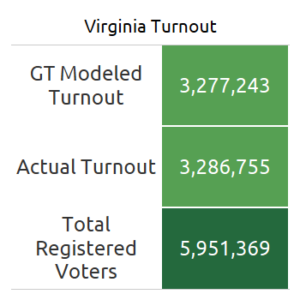14 Nov The Malarkey Election
The American electorate has changed.
 In 2017, just over 2.6 million votes were cast for Governor, a race Republicans lost by nearly 9 points. At the time, that was considered nearly impossibly high turnout compared to the less than 2.3 million votes cast in 2013. Our data in June 2017 indicated that presidential-year Democrats in Northern Virginia especially were fired up and ready to turn out that November. If only 2.6 million Virginians had cast ballots again in 2021, Republicans likely would have lost the election in that scenario. The additional voters who made up the gap between the 2.6 million who voted in 2017 and the 3.2 million projected for 2021 were disproportionately middle- and low-propensity Republican voters who cast ballots in the Presidential election of 2020 and may have never voted in a gubernatorial election ever before.
In 2017, just over 2.6 million votes were cast for Governor, a race Republicans lost by nearly 9 points. At the time, that was considered nearly impossibly high turnout compared to the less than 2.3 million votes cast in 2013. Our data in June 2017 indicated that presidential-year Democrats in Northern Virginia especially were fired up and ready to turn out that November. If only 2.6 million Virginians had cast ballots again in 2021, Republicans likely would have lost the election in that scenario. The additional voters who made up the gap between the 2.6 million who voted in 2017 and the 3.2 million projected for 2021 were disproportionately middle- and low-propensity Republican voters who cast ballots in the Presidential election of 2020 and may have never voted in a gubernatorial election ever before.

In 2020, President Trump turned out millions of new supporters who not only didn’t vote in previous elections, but would have hardly considered voting for a Republican in them. We saw this in battleground states during the 2020 election itself, a group of voters in our data who were more often younger men without a college degree who were certain they couldn’t stand Joe Biden, but less certain whether they were going to vote. These voters were missed by the professors and the public pollsters, which is one reason why their predictions about President Trump’s performance in that election were so far off the mark. These voters continue to make their voices heard today, loudly.
We see a similar scenario in New Jersey. At the time of writing, 2,575,943 votes have been reported in the race for Governor, with a margin of 2.9 points separating the Republican Jack Ciattarelli and the Democrat incumbent Phil Murphy. In 2017, less than 2.2 million votes were cast for Governor, with a margin of 14 points separating Murphy and the Republican nominee Kim Guadagno. Our data for the Republican State Leadership Committee in June of this year showed a clear enthusiasm advantage for Republicans, and a competitive election in a turnout scenario of 2.6 million votes cast with 2.5 points separating Ciattarelli and Murphy in our models.
The swing vote in both the Virginia and New Jersey elections was a group that we’ve nicknamed Malarkey Voters. These are voters who broke disproportionately for Joe Biden in 2020 but took a stand against specific issues we tested that identified their willingness to break from their party on others, even in this highly-polarized era. In short, they’re Democrats against nonsense.
When Democrat candidates come out for something nutty like saying “I don’t think parents should be telling schools what they should teach,” as Terry McAuliffe foolishly (and truthfully) stated in late September, these voters are the ones willing to say they disagree. We found a positive correlation between these voters and the places where Governor-elect Youngkin most overperformed President Trump’s vote share from 2020. In New Jersey, we found Democrats who opposed their party’s efforts to “reimagine” law enforcement or distributing Covid relief funds to illegal immigrants. Those two issues popped among persuadable voters in all five legislative districts we targeted with the Republican State Leadership Committee in the Garden State, picking up six Democrat-held Assembly seats, defending another two Republican-held Assembly seats, and defeating two Democrat incumbents in the Senate within them.
In both states, suburban voters came back to Republicans in a big way. Phil Murphy’s foolish comment that “if taxes are your issue, then New Jersey’s probably not your state” was brought into clear focus to voters. The strongest correlation in our data between Jack Ciattarelli’s performance compared to President Trump’s in 2020 was among voters more responsive to fiscal issues like New Jersey’s unexpected massive budget surplus and its totally-expected massive property taxes.
However, a deeper dive into the data suggests that the coalition that deserves the most credit for flipping the Virginia House of Delegates and won nearly a dozen key legislative races in New Jersey is in fact made up of multicultural working-class voters. All but one of the seven Virginia House of Delegates districts flipped from Democrat to Republican in 2021 were below average on a turnout-weighted index of college education and household income. In New Jersey, every targeted district that flipped from Democrat to Republican or successfully defended was below or exactly average. Control of the New Jersey Assembly is now in play for the next elections scheduled for 2023, and over 70 percent of New Jersey’s counties (15 of 21) will be represented by a Republican in the New Jersey Senate in the next term, giving conservatives new power to stop Governor Murphy’s far-left appointments.
In the next legislative session, Bridgeton (15.5% non-Hispanic white), Atlantic City (15.6% non-Hispanic white), and Asbury Park (31.1% non-Hispanic white) will all be represented by new Republicans in the New Jersey Assembly. Petersburg (15.4% non-Hispanic white), Emporia (24.5% non-Hispanic white), and Hampton (38.2% non-Hispanic white) will all be represented by new Republicans in the Virginia House of Delegates.
A Republican coalition of working-class people and parents of all backgrounds is a powerful force that can and will win elections in every part of our country, empowered by Democrats who show the courage to stand up and call out nonsense when they hear it. Joe Biden proposing to send our tax dollars to illegal immigrants as “compensation” after entering our country illegally? Malarkey!

